Monarch rearing, tagging and releasing survey
Tuesday, July 6th, 2021 at 9:23 am by Chip TaylorFiled under Monarch Biology | Comments Off on Monarch rearing, tagging and releasing survey
INTRODUCTION
In the middle of Covid-19 last June, we conducted a survey of those who rear, tag and release monarchs. Life has been interrupted in many ways over the past year, and we are just now getting around to summarizing the responses. While we were targeting those who rear and tag, many people who simply rear and release monarchs responded as well, and we are thankful for those responses. We assured everyone that their information would not be shared and that we wished to simply understand how rearing was being conducted. The number of people who responded (N=1165) exceeded our expectations, and their responses probably represent a good sampling of the reasons people engage in rearing and their rearing practices. As explained below, one of our intentions of the survey was to identify best practices for rearing and releasing. Unfortunately, the survey doesn’t provide the kind of data needed to establish best practices. What it does tell us is that tagged monarchs reared under a broad range of conditions have been recovered in Mexico. It also tells us that while the majority of people who rear, tag and release have not had recoveries, some 20.2% (159/787) reported success. We had hoped that sorting through the conditions reported for those who were successful would help us identify best practices. It doesn’t. There are too many variables which may include things we don’t know about the conditions that lead to diapause and then sensitivity to environmental changes that result in migratory behavior. To sort out the conditions associated with rearing and migratory success, we would have to know the numbers tagged, the dates and locations of release as well as more information about the instars collected or started and rearing methods. We will get those answers in time. In the meantime, we can make some general observations about what needs to be done to rear hardy and healthy monarchs.
Reasons for this survey
As most of you know, Monarch Watch was founded as a monarch tagging program in 1992. At that time, we promoted the tagging of wild caught monarchs, and for a number of years we assumed that our volunteers were only tagging monarchs caught at flowers or collected at overnight roosts. Late in the 1990s, it became clear that some people were tagging monarchs they had reared. At that time, we didn’t pay much attention since rearing and tagging seemed to be a small proportion of all tagging. However, by 2003 it was evident that many more people were beginning to rear, tag and release monarchs. While we didn’t know whether such practices would influence the recovery rate, we decided to be safe, that is, to be able to sort the wild from the reared when analyzing the data. So, we asked participants to indicate on their data sheets, starting in 2004, whether the monarchs they tagged were wild or reared.
Perhaps inspired by the publicity about the decline in monarch numbers and/or the petition to declare the monarch a threatened species, the creation of numerous Facebook sites dedicated to monarchs and other factors, the number of reared, tagged and released monarchs has outnumbered those that are wild caught and tagged for the last several years. Although the tagging records indicate that thousands of reared, tagged and released monarchs arrive at the overwintering sites in Mexico and survive through the winter, it is also clear that the likelihood of reaching Mexico is lower for reared monarchs. We want to know why. We need to sort out why some people who rear, tag and release have much higher recovery rates than others. So, we would like to determine how monarchs have been reared and whether tagged monarchs have been recovered in Mexico.
One reason for the survey has to do with the results in three widely cited studies that proport to show that reared monarchs do not orient properly or are too small or weak to reach Mexico (Davis et al, 2020, Tenger-Trolander, et al 2019, Tenger-Trolander and Kronforst, 2020). While those results may apply to some reared monarchs, it clearly doesn’t explain why almost 2000 reared, tagged and released monarchs have been recovered in Mexico. However, in support of the points raised in these papers, it is clear that the rate of success of reared monarchs in reaching Mexico is much lower than that of wild tagged monarchs. Given that some reared monarchs may lack the ability of orient and migrate, and others may simply be less fit to make the migration, why are many reared monarchs successful in reaching Mexico? It appears that it is easier to fail than to succeed. Although we do not promote rearing and tagging, it seems likely this practice will continue. Assuming this to be the case, we need to understand the reasons for success and failure in order to help those who are engaged in this practice. The survey is the first step in developing a set of standard operating procedures (sops) for rearing that improve the chance that reared monarchs will reach Mexico and will successfully survive the winter. In the end, our objective is NOT to tell people what to do but to provide them with information that will improve the hardiness, health and overall fitness of the butterflies they rear.
Results of the survey
Although 1165 people responded to the survey, because the questions did not apply to all respondents, many of the questions lacked as many answers. Some questions allowed us to assign percentages to the responses. Others did not because two or more of the responses applied or what appeared at the outset to be one question was actually two.
DISCUSSION
As I indicated in the introduction, we expected that we would be able to identify best practices based on the recovery of reared monarchs in Mexico. Specifically, we expected higher recoveries for monarchs reared outside on potted or growing plants that were caged in some way to protect from predators. Next, we expected some success with monarchs reared in cages on porches or other facilities that were exposed to natural temperatures and light. We even expected some success by those who reared monarchs indoors but with an exposure to natural light through windows. What we didn’t expect were reports of recoveries in Mexico by 5 respondents who reared monarchs in rooms without natural light most or all the time. Three of them reared monarchs in rooms with no windows. For monarchs reared in windowless rooms to succeed in entering diapause and then migrating to Mexico is striking. This result is unexpected since it is contrary to studies showing that shortening daylength is required to enter diapause. Further, there were no obvious differences in the number of recoveries of those who reared their monarchs outdoors vs indoors. There were 15 respondents that indicated their rearing was conducted indoors without access to natural light. We need to learn more about these rearing conditions. Since recoveries involve variables, such as point of origin, date of release and numbers released, we will need to dig further into the tagging and recovery data to explain the relationships between rearing conditions and recoveries.
Indoor conditions
Our question dealing with indoor temperatures wasn’t targeted very well and the responses weren’t sufficiently helpful. Observations of the conditions in both the field and lab suggest that diapause induction occurs best when there are distinct differences between day and nighttime temperatures. Night time lows are usually in the 60s, often in the 50s, with mean temperatures of less than 80F. Constant temperatures in the high 70s appear to be too high for diapause induction meaning that the butterflies become reproductive. It follows, that monarchs reared under these conditions would not migrate. More work is surely needed on the factors that lead to both diapause induction and those that lead to reproduction.
Motivation
The motivations of those who rear monarchs were pretty clear. Rearing monarchs is fun, interesting and a bit challenging, and many appear to be motivated to rescue monarch eggs and larvae that would likely be consumed by predators or parasitized by flies. This idea of monarch rescue has resonated and is clearly hard for many to resist. After all, what harm could there be in rescuing a monarch larva from certain death in the mouthparts of a wasp of assassin bug? For many, monarch rescue also means that this practice can contribute to the monarch population, and this goes along with a general interest in monarch conservation. Overall, it’s a powerful combination, something that is fun, combined with the satisfaction of rescuing vulnerable immatures with the notion of adding to the population in a way that contributes to the conservation of the species. Educating children and adults wasalso cited as motivations for rearing. Interestingly, rearing monarchs to tag them was the lowest driver on the list.
Affiliation
Most rearing was conducted at homes (76%) or at a combination of home, school, business and other (11%) with the remaining 13% reared at schools, nature centers and businesses.
Season
Most rearing was conducted in the summer and fall although there were also reports of rearing being conducted in the spring.
Source of eggs and larvae
We were interested in the sources of eggs and larvae used in the rearing since there were some concerns that people were buying stock from commercial breeders that might have been less fit to migrate. However, the responses show that most of the immatures were obtained on their property or nearby properties with only 10 indicating they had purchased eggs.
Female egg layers
We asked a question about obtaining eggs from wild mated females or obtaining eggs from females that were mated to captive bred males. Our curiosity in this case was based on assertions by critics of rearing that inbreeding was involved that would be detrimental to the population. In this case, there were only 18 responses indicating that reared monarchs were allowed to breed and produce eggs. Whether inbreeding occurs under these conditions would depend on the genetic relatedness of the pairings. In the case of brother x sister mating, it could be high, but if the males and females are unrelated, the pairings would be no different from that of wild males and females.
Indoor conditions
Most of the indoor rearing is conducted at room temperature with exposure to natural light through a window. However, there were 15 who indicated that the rearing was conducted in a space with no exposure to natural light. As mentioned above, 5 of these respondents indicated that monarchs reared under these conditions were recovered in Mexico.
Lighting
Most who rear monarchs indoors did not use light timers to increase the photoperiod.
Shelter conditions
This question was really two questions – what type of shelters were used and what were the physical conditions. The only useful information in this case is that most respondents used natural temperatures and light.
Sanitation, washing leaves, fresh food, types of foliage used, crowding and changing practices
These questions were intended to provide some insights about the rearing process. We wanted to know how often rearing containers were cleaned, whether the leaves were washed, how often new foliage was provided, the type of foliage used, how many larvae were being reared together and whether people were changing their practices from time to time to improve their efficiency and success at rearing the larvae to the adult stage. The responses to these questions indicate that most people engaged in rearing have adopted sanitation, feeding and crowding practices that, if followed closely, will lead to the production of healthy monarchs.
Milkweeds
When asked what species of milkweeds were used to feed larvae, there were lots of answers since the use of milkweeds often depends on what is available. Still, there was a clear hierarchy that probably reflects the fact that the majority of those who rear are located in the northeast. Most frequently used was common, followed by swamp, and tropical milkweeds. Of the top 3 used, tropical only accounted for about 11% of the responses.
O. e. questions (Ophryocystis elektroscirrha)
We asked a number of questions about O.e. to determine how those rearing monarchs were dealing with this disease. The sanitation questions fit here as well since washing leaves in particular could eliminate many if not all of the O.e. spores from the leaf surfaces. Still, over 88% of the respondents did not test for O. e. or work with Monarch Health, an O.e. monitoring program directed by Sonia Altizer at the University of Georgia. There were fewer responses to the question about whether monarchs with O. e. were released, but of those, 61% said they did not. We also asked whether monarchs with O. e. were euthanized. This question is similar to asking if monarch with O.e. were released. The answer to the euthanize question generated 635 responses with 72% affirming that they euthanized monarchs with O. e.
Drying time
Because monarchs use most of the first day to mature and are not fully flight capable and therefore vulnerable to predation by wasps, dragon flies and some birds, we asked whether monarchs were released the first day or later. The answers indicated that only about 20% of the respondents routinely allowed monarchs to mature before releasing them. Another 42% indicated that the day of release varied.
Weigh and measure
Since forewing length and overall fitness are related to migratory success, we wondered how many people were aware of this and whether they made the effort to measure forewing length and weigh the monarchs before releasing them. As expected, the majority did not, yet 13 respondents indicated they did weigh monarchs, and 41 said they measured wing length. This question is related to tagging questions regarding whether all or only some reared monarchs are tagged and released.
Tagging
When we asked whether respondents tagged the monarchs they reared, a surprising 32% said no, they only rear to release monarchs locally. Since we were targeting those who rear and tag and didn’t really solicit responses from those who only rear and release, it seems likely that the proportion of those who only rear and release is larger than indicated in this survey. While most of the tagging was conducted during the recommended time framessome 7% indicated they tagged at other times. When we asked if only large monarchs or all monarchs were released, a surprising 14% indicated that they only tagged large monarchs. In the future, we can specify what is meant by large, but since most people were not measuring monarchs or aware of the size issue, we chose not to do so.
Recoveries
There were two questions on recoveries. One asked whether the respondents had recoveries, and the other asked the recovery rate – that is, the percent of all those tagged and released that had been recovered. Surprisingly, 22% reported recoveries and 20 indicated that their recovery rates were 1% or higher. Those are good numbers, typical of those, mostly in the Midwest, who have been tagging wild monarchs for many years.
CONCLUSIONS
The main conclusion we can draw from this survey is that the results, while in some ways robust, are insufficient. These results have failed to indicate that there is a standard or at least a better way to rear monarchs to assure migratory success. In fact, there are no clear trends in the rearing methods and, if anything, they indicate that monarchs reared under a great variety of conditions, including rooms without windows, are capable of entering diapause and successfully migrating to Mexico. An explanation, or at least a partial explanation, of the variability of the success in reaching Mexico may lie in the preconditioning 5th instar larvae experienced outdoors before they were brought into rearing rooms. To determine if this was the case, we compared the recovery rates for those who only reared wild collected 5th instars (N=17) with those who reared small larvae (N=68). The recovery rates were 29% and 19% respectively. Again, not much of a difference from the overall mean of 20.2% with the possibility that the lower % for those rearing small larvae was due to the greater percentage being reared in the East vs the Midwest. Unfortunately, our survey was too general, with many sample sizes that were too small, to pick up on details such as these. Additional information is needed about the rearing conditions, and the age of the larvae, in all cases with recoveries, and we need to know more about the size and mass of those tagged. Further, more experimentation is needed to determine the conditions that lead to the induction of diapause and migratory behavior. We also need to establish the temperatures that block diapause induction or lead to the breakdown of diapause once monarchs begin migrating.
In spite of the limitations of the survey, we can pass along a few observations from the tagging results that bear on migratory success. Analysis of tagged wild and reared monarchs shows that success in reaching Mexico is a function of the site of origin and the date of release. Monarchs released late in the migration and from more distant locations are less successful in reaching Mexico. Further, a number of studies have indicated that large monarchs dominate the leading edge of the migration and apparently have the highest probability of reaching Mexico. Rearing last generation monarchs outdoors on caged rooted or potted plants seems most likely to produce monarchs that enter diapause and migrate. Of course, care should be taken not to expose host plants to egg laying females to prevent O.e. spores from contaminating the leaves. The alternative is to sanitize the rooted or potted plants before using them as food for developing larvae.
REFERENCES
Davis, A. K., Smith, F. M. and A. M. Ballew. 2020. A poor substitute for the real thing: captive-reared monarch butterflies are weaker, paler and have less elongated wings than wild migrants. Biol. Lett.16 20190922.
Tenger-Trolander, A., Lu, W., Noyes, M. and M. R. Kronforst, 2019. Contemporary loss of migration in monarch butterflies. PNAS July 16, 2019 116 (29) 14671-14676
Tenger-Trolander, A. and M. R. Kronforst, 2020. Migration behaviour of commercial monarchs reared outdoors and wild-derived monarchs reared indoors Proc. R. Soc. B.28720201326
TABLES
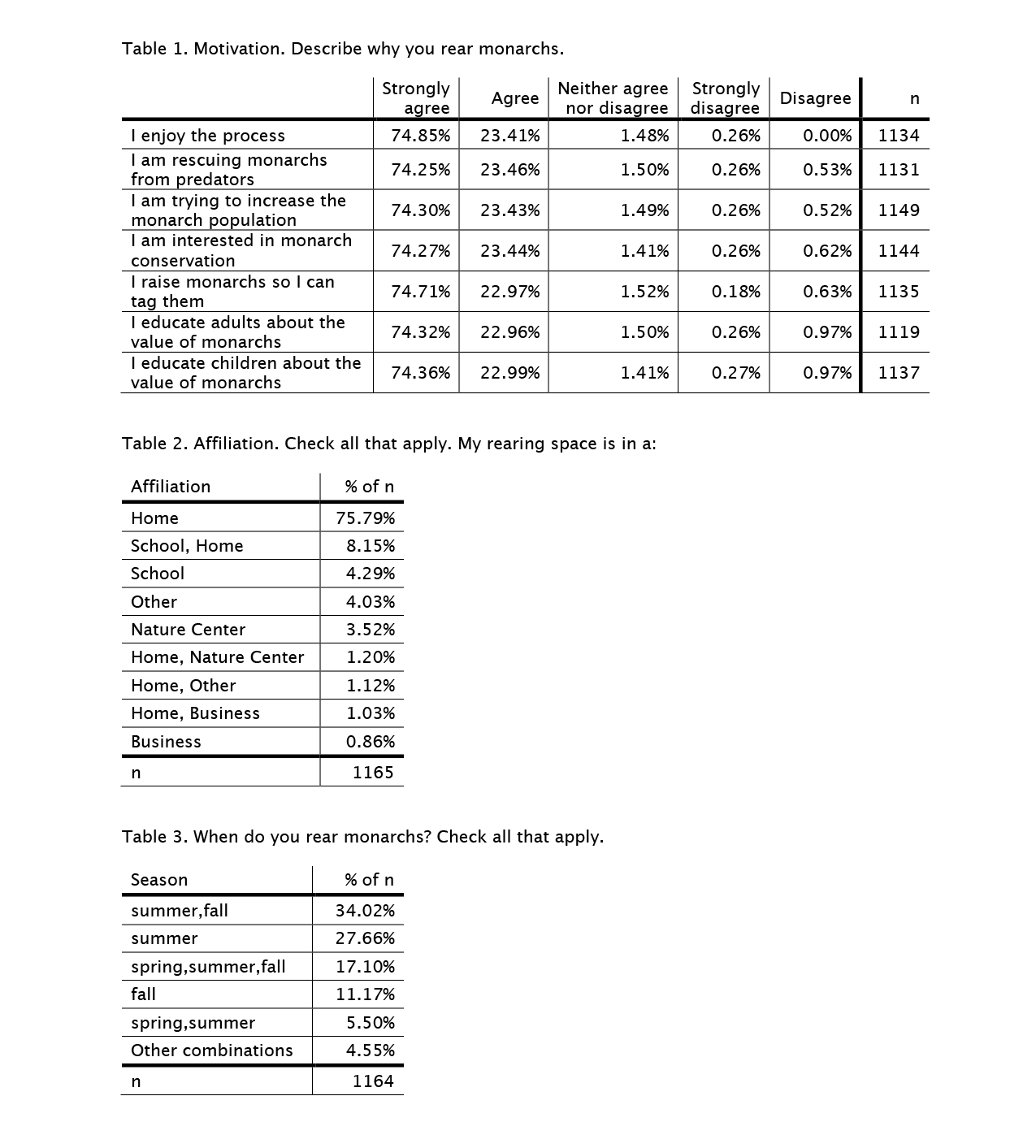
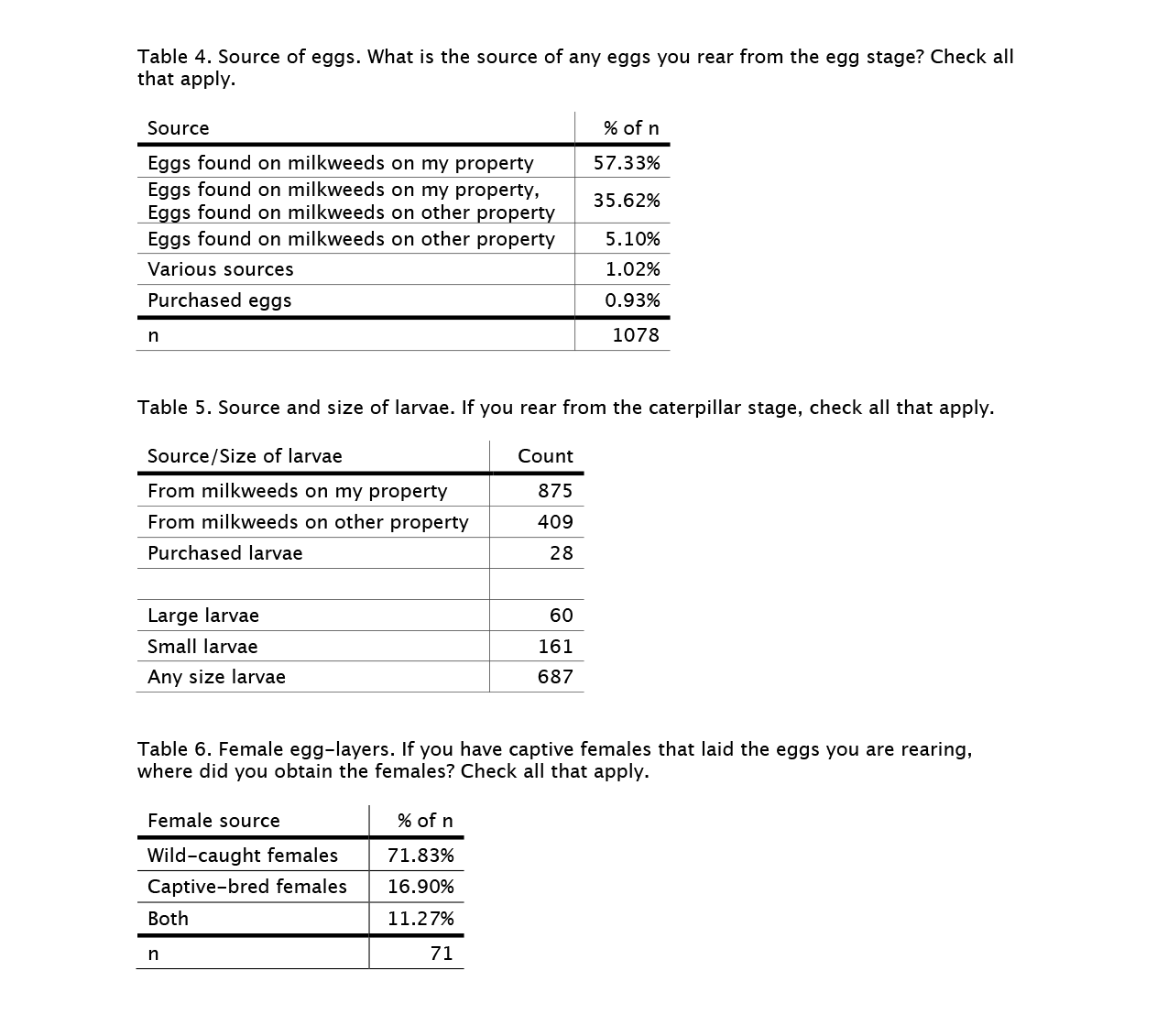
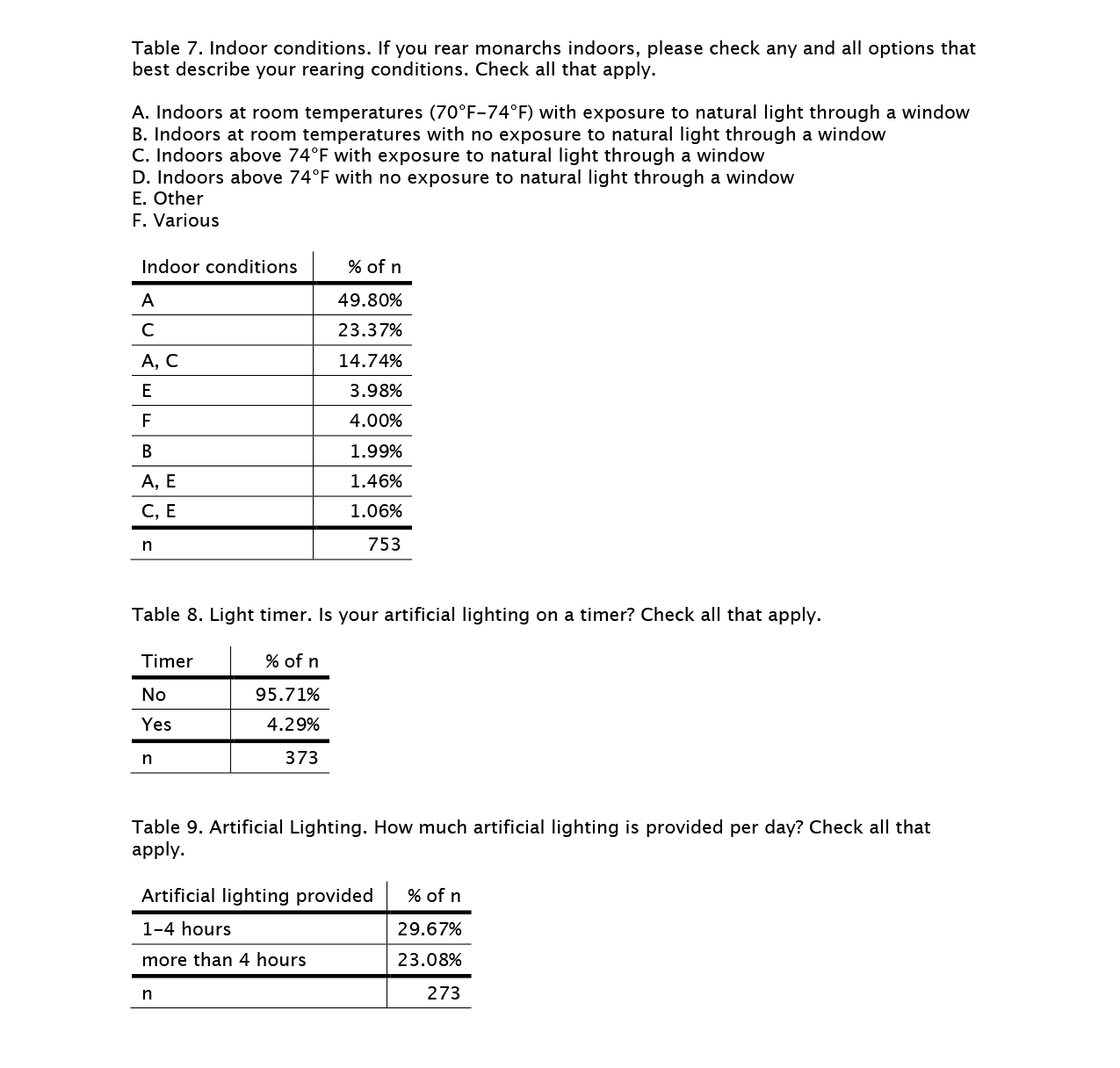
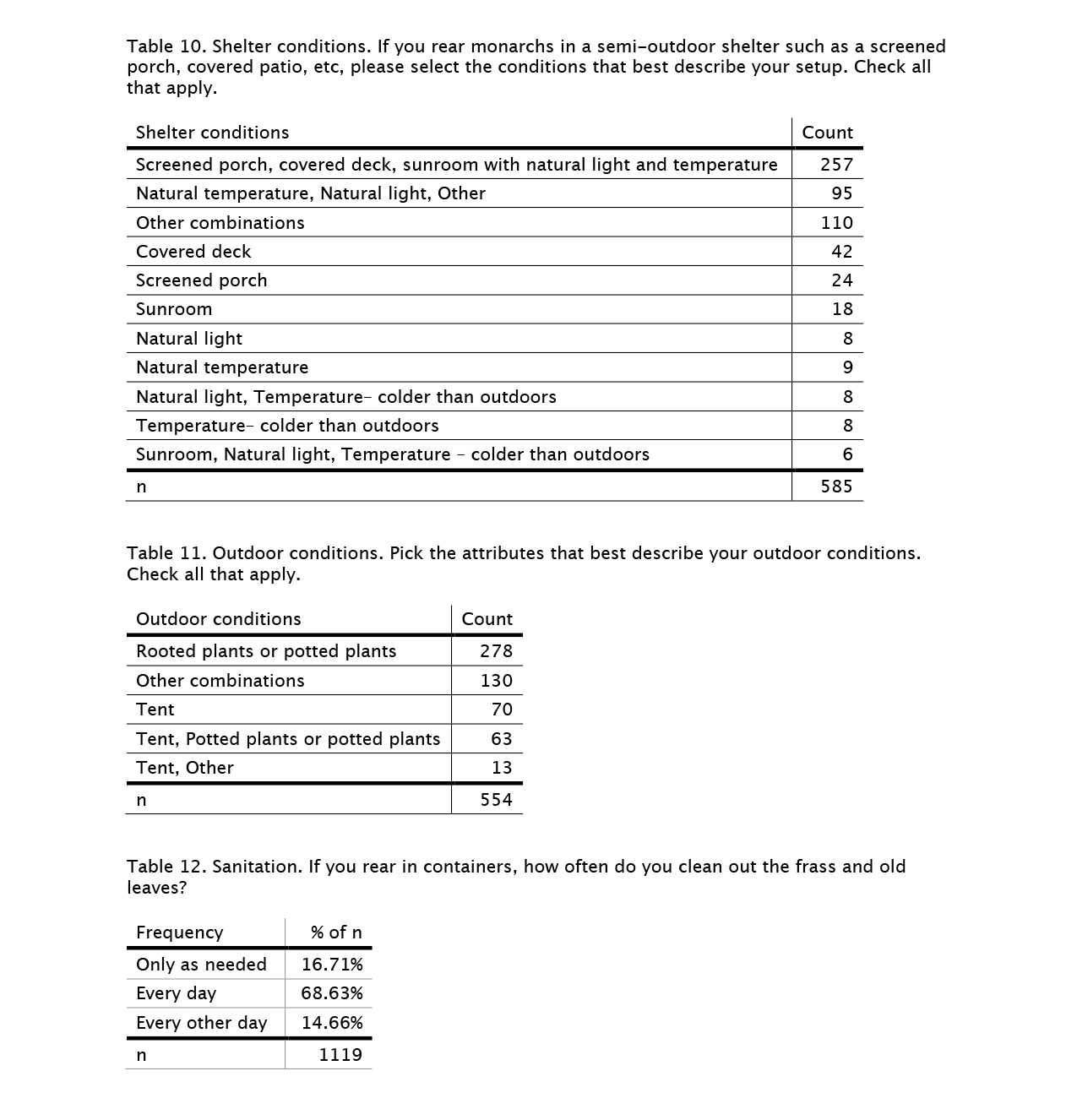
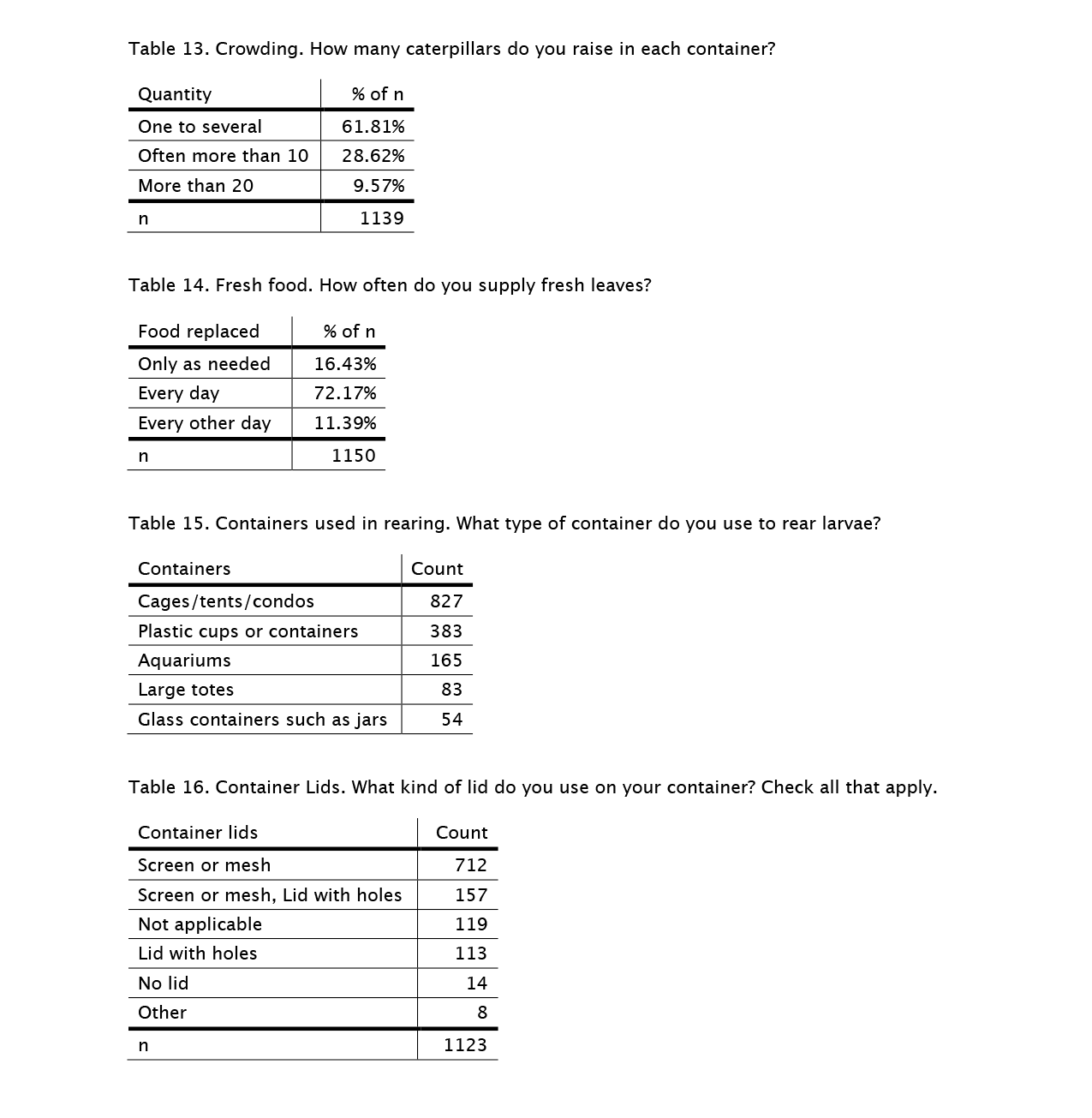
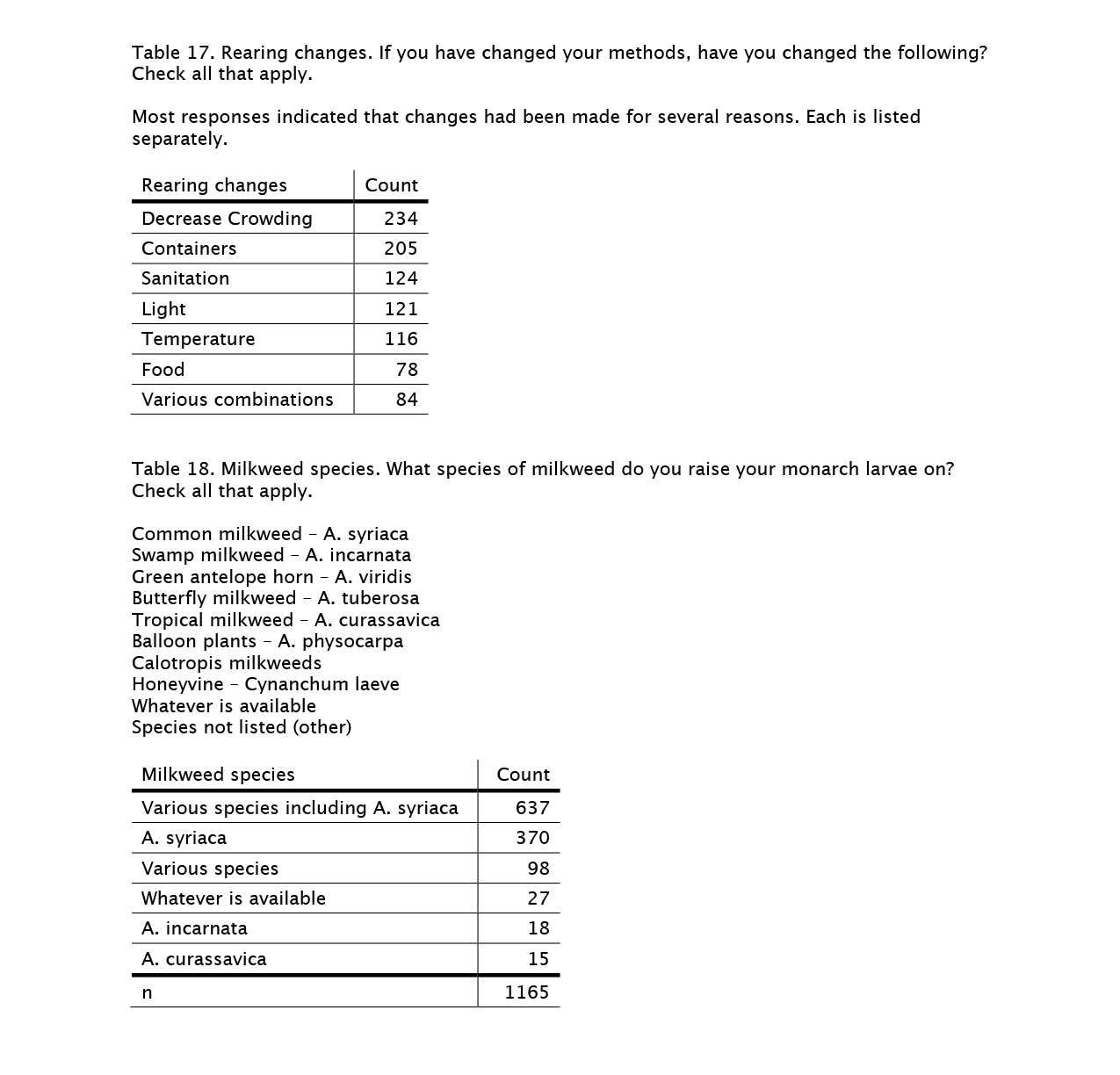
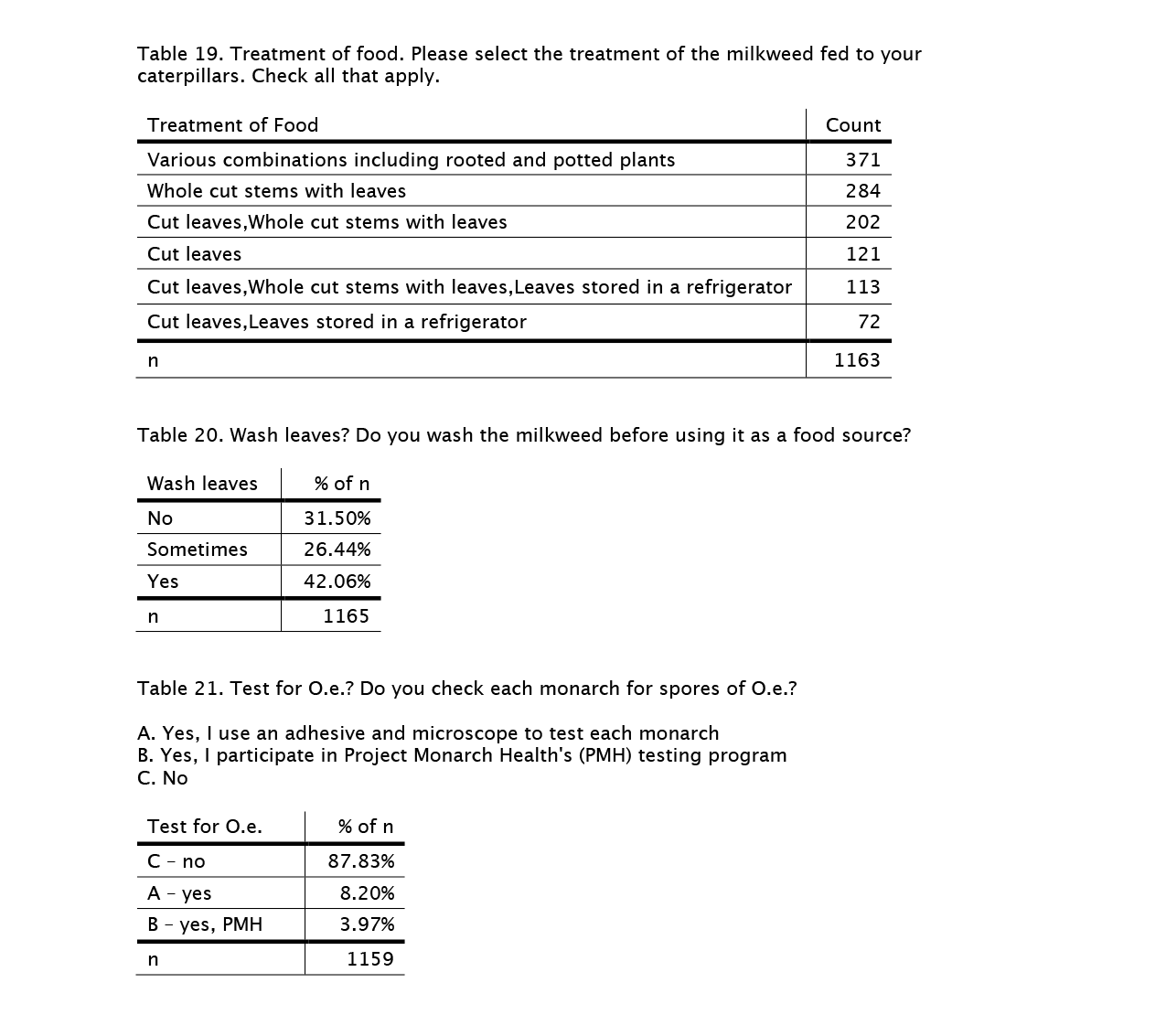
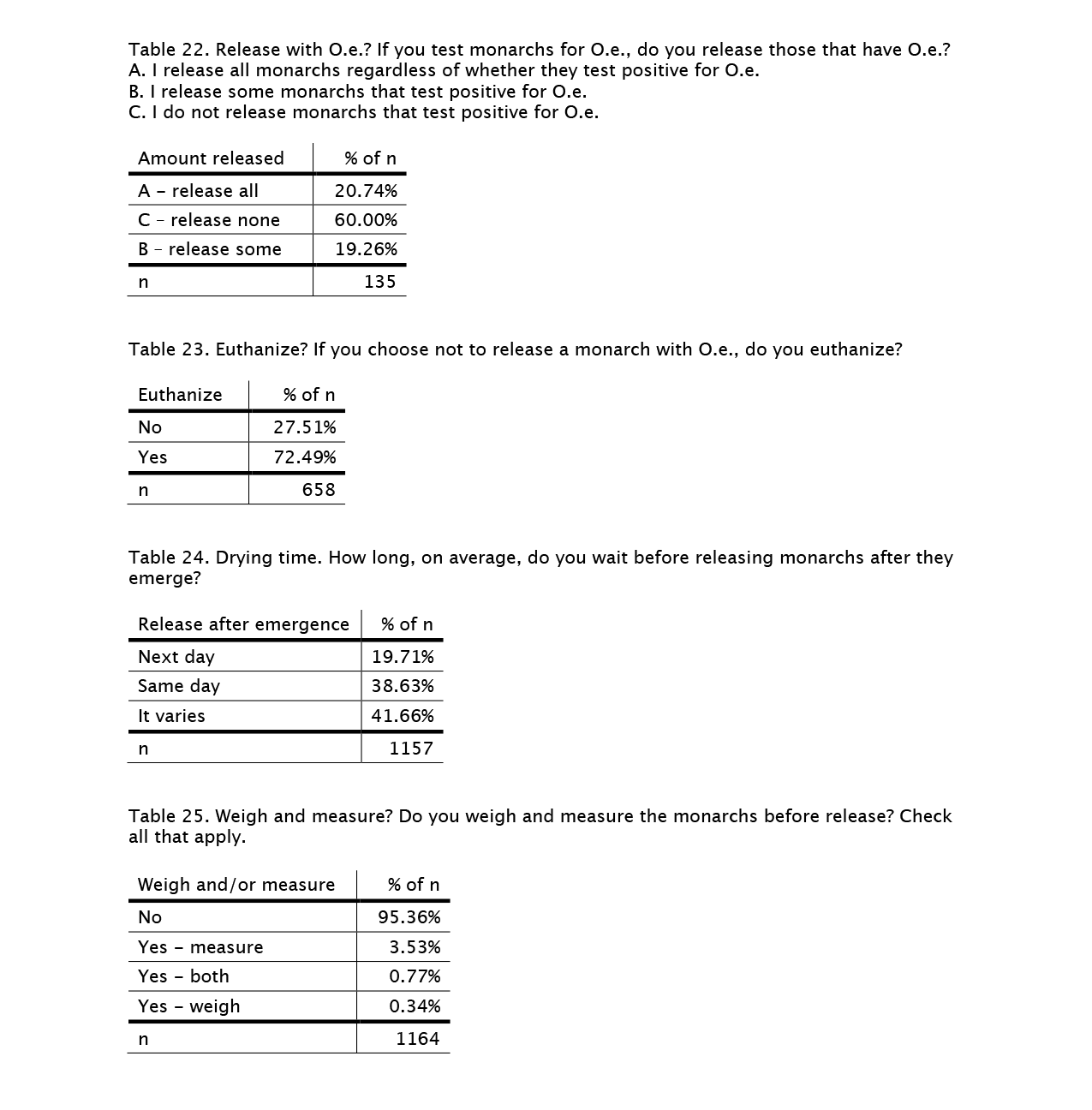
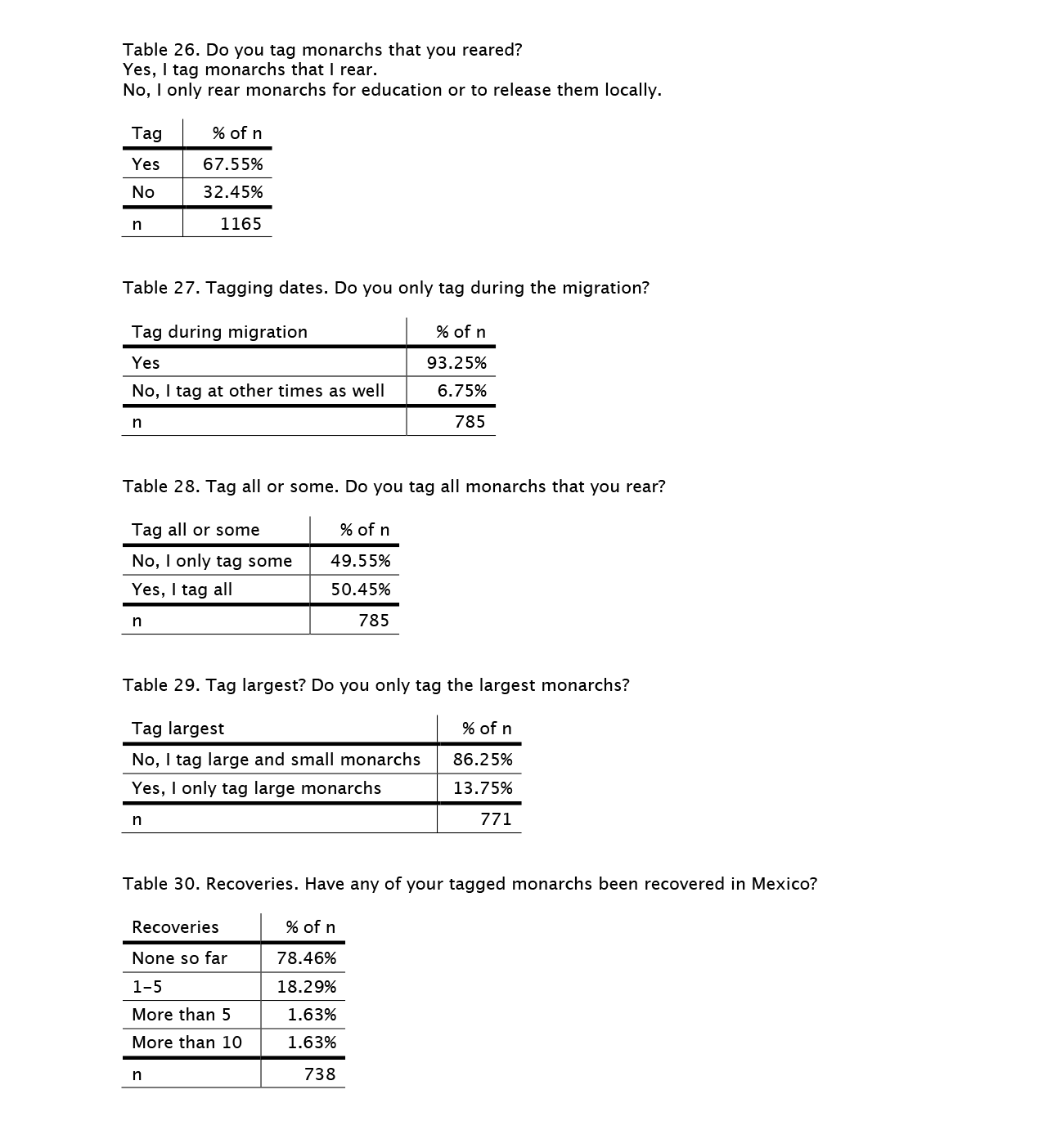
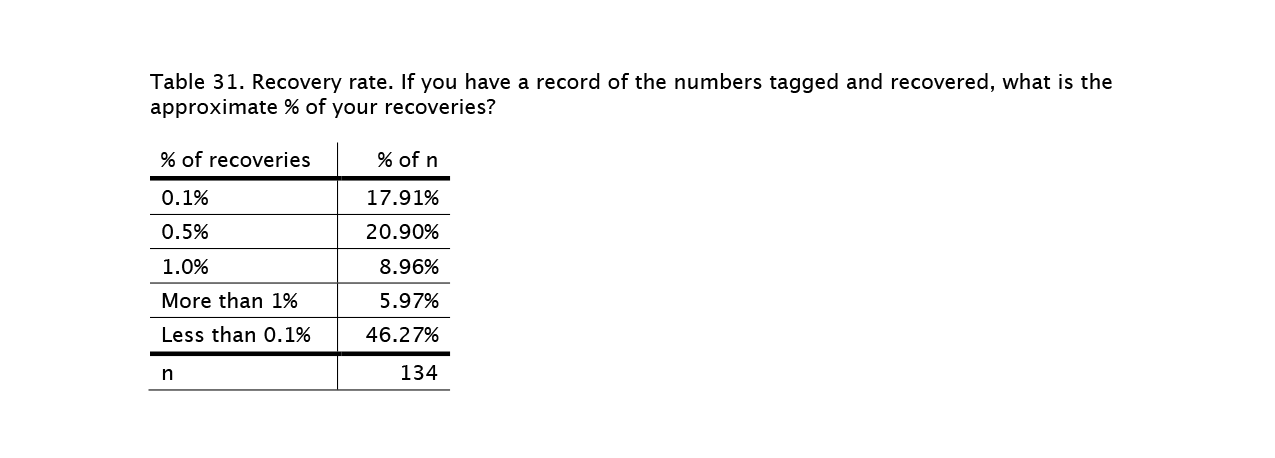


Sorry, comments for this entry are closed at this time.